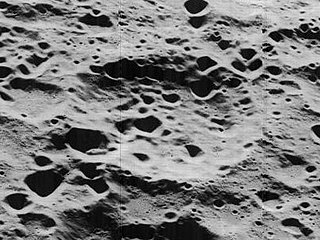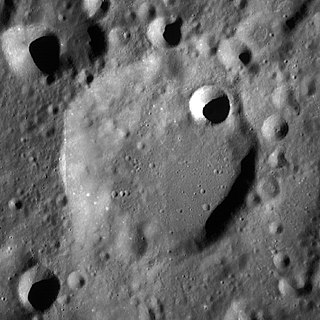
Fracastorius is the lava-flooded remnant of an ancient lunar impact crater located at the southern edge of Mare Nectaris. To the northwest of this formation lies the crater Beaumont, while to the northeast is Rosse.

Alekhin is a lunar impact crater that is located on the southern hemisphere on the far side of the Moon. It lies to the north of the crater Zeeman, and south-southeast of Fizeau. To the west lies Crommelin, and east-southeast is Doerfel.

Avogadro is an ancient lunar impact crater that is located in the northern hemisphere on the far side of the Moon. The formation has been heavily worn and eroded by subsequent impacts, so that the rim is now little more than a rounded edge surrounding the crater depression. The crater floor is equally worn, being covered in a multitude of smaller craters of various sizes. Many of these smaller craters have also been eroded, leaving little more than a faint trace on the surface.

Byrd is an irregular lunar impact crater that is located near the north pole of the Moon. The north rim of Byrd is nearly connected to the crater Peary, a formation that is adjacent to the pole. The smaller crater Gioja is attached to the remains of the southwest rim.

Crommelin is an ancient lunar impact crater that is located in the vicinity of the south pole of the Moon, on the far side. It lies to the north of the large crater Zeeman, and to the east-northeast of Numerov.

Dawson is a lunar impact crater that lies on the southern hemisphere on the far side of the Moon. It lies across a crater triplet: the southeast rim is intruding into the crater Alekhin; the northwest rim also intrudes into the larger satellite crater Dawson V, and the northeast rim is attached to the comparably sized Dawson D. To the south of this formation is the large crater Zeeman. West of Dawson is the crater Crommelin, and to the north lies Fizeau.

Becquerel is a lunar impact crater that lies in the northern hemisphere on the far side of the Moon. This is an ancient and heavily worn formation that is now little more than an irregular buri in the surface. The outer rim has been worn and reshaped until it forms a rugged, mountainous region around the flatter interior.

Berzelius is a lunar impact crater located in the northeast part of the Moon's near side. It lies to the southeast of the crater Franklin, and to the northwest of Geminus.

Bjerknes is a lunar impact crater that is located in the southern hemisphere on the rugged far side of the Moon. The crater lies behind the southeastern limb, and beyond the region that is sometimes brought into sight through libration. Thus this crater can not be viewed from Earth, and has only been seen from orbit. Nearby named craters are Clark to the east, and Pogson to the south-southwest.

Demonax is a lunar impact crater near the southern limb of the Moon. This location makes the crater difficult to observe due to foreshortening. The crater is also illuminated at a very low angle, when it is in the sunlit side. Demonax lies just to the north of the crater Scott, one of the south polar formations. To the north-northwest is Boguslawsky.

Epigenes is a lunar impact crater that is located in the north part of the Moon, and is sufficiently close to the northern limb to appear significantly foreshortened from the Earth. It lies just to the northwest of the remains of the walled plain W. Bond. Due north of Epigenes is Goldschmidt, and the ruined crater Birmingham lies just to the southwest.

Chevallier is a lunar impact crater that is located in the northeastern part of the Moon's near side, about a crater diameter east-southeast of the prominent crater Atlas. To the south-southeast of Chevallier is the flooded crater Shuckburgh.
Cooper is a lunar impact crater that is located in the northern hemisphere on the far side of the Moon. It lies to the east of the large walled plain D'Alembert, and west-southwest of the crater Chappell.

Cichus is a lunar impact crater that lies in the southwestern part of the Moon, at the eastern edge of Palus Epidemiarum. Just to the northeast and nearly contacting the rim is the lava-flooded crater remnant Weiss. The crater is named after Italian astronomer Cecco d'Ascoli.

Comstock is a lunar impact crater that is located on the far side of the Moon. It lies to the northeast of the walled plain Fersman, and north of the crater Weyl.

Comrie is a lunar impact crater. It is located on the rugged far side of the Moon relative to the Earth, beyond the western limb. Nearby craters of note include Ohm to the south-southwest, Shternberg to the southwest, and Parenago to the northeast.

Douglass is a lunar impact crater on the far side of the Moon. It lies to the southwest of the crater Frost and south-southwest of the large walled plain Landau.

Dziewulski is a lunar impact crater on the far side of the Moon. It lies between the craters Edison to the north and Popov to the south. The outer rim of this crater has been considerably worn by impacts, particularly along the southwest quadrant where the satellite crater Dziewulski Q overlies the rim and the interior floor. The northern rim is also heavily disrupted, and several small crater lie along the southeast rim. The interior floor and surrounding terrain has been resurfaced.

Dunér is an old lunar impact crater that is located in the northern hemisphere on the far side of the Moon. It lies to the southeast of the crater Chernyshev, and west-southwest of the Perkin–Debye crater pair.

Evdokimov is a lunar impact crater on the far side of the Moon. It lies to the east of the crater Evershed, and west-southwest of Gadomski. This is a worn and eroded feature with a somewhat indistinct outer rim that is little more than a slight ridge in the surface. The rim is better formed along the western and eastern sides. A small crater with a relatively high albedo lies along the inner wall to the northeast, and is surrounded by a small, bright skirt of ejecta. The interior floor is nearly featureless, with only a few indistinct small crater rims marking the surface.



















